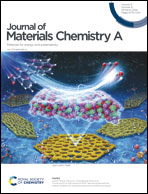Mixed anion effects on structural and electrochemical characteristics of Li4Ti5O12 for high-rate and durable anode materials†
Abstract
Lithium titanate (Li4Ti5O12 or LTO) is a zero-strain lithium-insertion anode that experiences no volume change during the charge–discharge cycles. Combining experimental and computational approaches, this study reveals that the exceptional rate capability and cyclability of LTO anodes can be achieved through the utilization of mixed-anion materials, which may possess fundamentally distinct kinetic mechanisms compared to oxides. By incorporating halogen ions (F−, Cl−), electron conductivity is enhanced via d-electron doping. Additionally, the repulsion between Li+ ions in the transition state and the alteration in Li's coordination number significantly affects the energy profile of Li+ ion diffusion along the most energetically favorable pathway in the LTO lattice. Notably, F− or Cl− doping on the LTO surface significantly reduced the presence of pentacoordinate Ti atoms on the surface due to halide bonding, resulting in mitigation of electrode deformation due to gas evolution, which is a typical characteristic of LTO electrodes. These novel insights offer new avenues for discovering high-rate electrode materials capable of delivering high cyclability.



 Please wait while we load your content...
Please wait while we load your content...